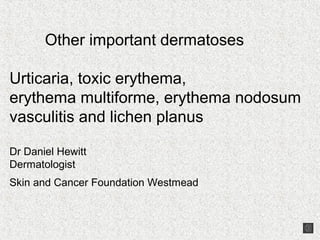
Important dermatoses: urticaria, toxic erythema, erythema multiforme, vasculitis, panniculitis and lichen planus
- 1. Other important dermatoses Urticaria, toxic erythema, erythema multiforme, erythema nodosum vasculitis and lichen planus Dr Daniel Hewitt Dermatologist Skin and Cancer Foundation Westmead
- 2. Objectives This module introduces urticaria, toxic erythema, erythema multiforme, lichen planus, vasculitis and panniculitis. The aim is to understand these important dermatoses – their distinct clinical features, their causes and their treatments.
- 3. Urticaria This is the presentation of red patches and weals. Characteristically itchy. May change shape and last from several minutes to several hours.
- 4. Classic examples of urticaria Classic examples of urticaria
- 5. Urticaria is the archetypal “dermal” erythema. There is swelling in the dermis producing a firm, raised lesion but the epidermis is unaffected. Therefore, there is no scaling or weeping clinically.
- 6. Urticaria
- 7. Pathogenesis There is a release of histamine and other chemicals from mast cells. This leads to an increase in vascular permeability and tissue swelling. Urticaria may be associated with infections, medications, physical stimuli or foods. Usually, no particular external cause is identified. Most cases do self-resolve and are classififed as acute urticaria. Chronic urticaria lasts longer than 3 months. Acute cases are more frequently related to an external allergen. Chronic urticaria is often due to antibodies formed by the patient reacting against IgE on their own mast cells (“auto-antibodies.”)
- 8. Treatment Oral antihistamines are the mainstay. As the pathology is quite deep, topical treatments are generally of limited benefit. Oral antihistamines are used as a regular dose. They are more effective in preventing new wheals forming than in suppressing widespread weals that are already present.
- 9. Non-sedating antihistamines are used first-line eg cetirizine 10mg as a daily morning dose loratadine 10mg as a daily morning dose In more resistant cases the dose can be increased to 2 to 3 times the starting dose. This is generally safe, but patients need to be warned about possible drowsiness.
- 10. Toxic erythema This is a characteristic presentation of erythematous macules and papules. It is usually most prominent on the trunk. The apearance is due to dilatation and sometime mild inflammation of capillaries and arterioles. This reaction pattern may be described clinically as “morbilliform” (measles like) or exanthematous (like a viral exanthem)
- 11. The causes are numerous but comprise three main groups Drugs eg antibiotics, thiazides, anticonvulsants Infections eg streptococcal infections viral infections Systemic causes eg connective tissue diseases malignancy
- 12. A morbilliform toxic erythema
- 13. Toxic erythema
- 14. Erythema multiforme This is a reaction pattern skin with characteristic targetoid lesions. These have a dusky purple centre, an oedematous zone and then a red rim. The trunk, limbs and palms are often affected. Skin lesions can arise very quickly and patients may be systemically unwell. Mucosal surfaces may be involved leading to erosions of the oral mucosa and conjunctivitis. It is most often caused by viruses of the herpes family but can also be triggered by medications.
- 17. Panniculitis This is inflammation of the subcutaneous fat. Possible causes are pancreatic disease, trauma, cold, malignancies and connective tissue disease. There are many different forms of panniculitis, but the most commonly seen is erythema nodosum.
- 18. Erythema nodosum presents with painful red nodules on the shins and occasionally the forearms. It is most common in young adult women. The most common causes are infections streptococcal, especially pharyngitis viral infections tuberculosis medications sulphonamides salicylates nonsteroidal anti-inflammatories sarcoidosis pregnancy Sometimes no cause is identified
- 19. Erythema nodosum
- 21. Vasculitis This is inflammation of the blood vessels, most characteristically the post-capillary venules. The form seen most commonly in the skin is “leukocytoclastic vasculitis.” Clinically, the hallmark is palpable purpura. The purpura represents blood outside blood vessels and the swelling or palpability occurs because of the oedema developing due to the inflammation of the blood vessels. Sometimes larger blood vessels are involved. This has different manifestations in the skin and the patient is more likely to have systemic involvement.
- 24. The clinical assessment involves assessing for any systemic involvement (renal, joint, gastrointestinal and central nervous system) and looking for possible causes. Leukocytoclastic vasculitis is frequently idiopathic but causes include Drugs – antibiotics, especially sulphonamides and penicillin, thiazide diuretics, anticonvulsants Infections – streptococcal, hepatitis, Connective tissue diseases – systemic lupus erythematosus, rheumatoid arthritis Malignancies – lymphomas and leukemias
- 27. Lichen planus This is an abnormal immune reaction in the skin. The most characteristic presentation is with purple, polygonal and flat-topped papules and plaques that are often pruritic. Most often these are seen on the volar wrists, lower back and ankles but can occur anywhere. There are many other forms eg hypertrophic and mucosal lichen planus. The lacy white appearance characteristic on mucosal surfaces are known as Wickham’s striae. The mouth is involved in 50% of lichen planus involving the skin. It may be the only area affected.
- 28. Lichen planus
- 29. Lichen planus
- 30. Treatment of lichen planus can be very difficult. Topical steroids are often first line treatments. Other treatments include - Topical calcineurin inhibitors (eg tacrolimus) - Ultraviolet therapy - Systemic treatments including acitretin, methotrexate and prednisolone.
- 31. Conclusion Here we have introduced urticaria, toxic erythema, erythema multiforme, vasculitits, panniculitis and lichen planus. These all have characteristic presentations. Recognizing their clinical presentations is the first step in diagnosing and managing these conditions.